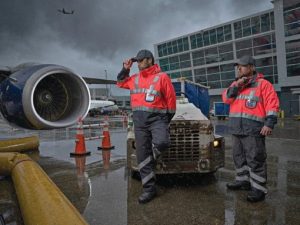
The Critical Role of Delta’s Meteorology Team
Every day, Warren Weston takes his seat at his desk in Delta’s Operations and Customer Centre in Atlanta, where he performs a vital role in ensuring the airline operates smoothly. As part of Delta’s in-house meteorology team—the largest among U.S. airlines—Weston and 27 other specialists monitor weather conditions that can impact every flight. Their work is not just about tracking the sky; it involves providing critical forecasts and insights that help make informed decisions across the airline.
The meteorology team's responsibilities go beyond simple weather updates. They continuously monitor atmospheric conditions, create detailed forecasts updated every six hours, and share these with various operational groups and flight crews. These forecasts are essential for planning safe and efficient flight routes, making adjustments when necessary, and ensuring passenger comfort and safety.
Two Focus Groups: Surface and Upper Air
Delta’s meteorology team is divided into two main groups based on their areas of focus. The first group, known as the surface group, monitors conditions around Delta’s major hubs and key airports. Their forecasts provide crucial information about potential obstacles that aircraft might face during takeoff and landing. This data helps operational teams make decisions regarding airport operations, such as managing delays or adjusting schedules.
On the other hand, the upper air group focuses on conditions above the ground, including turbulence, thunderstorms, and even volcanic ash. This group works closely with flight crews and planners to ensure flights remain safe and comfortable. For instance, if a volcano erupts along a flight path, the meteorology team alerts dispatchers in advance so the route can be adjusted accordingly.
Collaboration is Key
Effective communication and collaboration are central to the meteorology team’s success. Located within the Operations and Customer Centre (OCC), where operational decisions are made, the team can quickly interact with other departments. This proximity is especially valuable during irregular operations, where pinpointing the timing of severe weather is critical.
Each day begins with a briefing involving colleagues from across Delta’s operations. During this meeting, a five-day outlook is discussed, focusing on Delta’s primary hubs. This outlook is essential for planning and deciding whether changes to the operational schedule are needed. It also helps determine if customers should be notified about potential flight delays.
Throughout the day, the meteorology team updates forecasts every six hours, which remain valid for 30 hours. These forecasts guide decisions related to flight paths, staffing, and other operational factors.
Station Managers and Operational Planning
The forecasts produced by the meteorology team are accessible online for station managers at each airport. These managers use the forecasts to assess whether additional staffing or deicing operations may be required. For example, if a snowstorm is predicted, station managers can review the forecast and decide on the appropriate level of deicing and staffing needed.
Flight Planners and Dispatchers
Flight planners and dispatchers rely heavily on the meteorology team’s forecasts. These include visibility, cloud height, turbulence levels, and other factors that influence flight planning. By using these forecasts, they can determine if an aircraft needs extra fuel for an alternate airport in case of unexpected weather conditions.
“We look several hours ahead,” said Weston. “It’s like there are highways in the sky, and our forecasts help guide them to the best possible route.”
Flight Crew and Passenger Safety
Turbulence is a major concern for the upper air group, and communicating these forecasts to pilots and flight attendants is essential. Each pilot has access to an iPad in the cockpit that displays real-time weather information, including turbulence and thunderstorm forecasts. If a pilot detects an area of turbulence, they can collaborate with air traffic control to adjust altitude and avoid the disturbance.
Data Sources and Continuous Improvement
The meteorology team gathers data from multiple sources. Some of this data comes from the National Weather Service, while other information is provided by pilot reports sent directly from flight crews. These reports help refine turbulence forecasts, ensuring greater accuracy over time.
Another essential tool used by the team is the Weather Information Tool, a dashboard that provides a five-day outlook for all of Delta’s major hubs, including international locations. This tool highlights potential issues, allowing the meteorology team and other operational groups to plan effectively for staffing and operations.
A Commitment to Safety
At the heart of everything the meteorology team does is a commitment to safety. Whether it’s adjusting flight paths, preparing for severe weather, or ensuring passengers have a smooth journey, the team’s work plays a crucial role in Delta’s operations. As Weston emphasized, “Everything we do is geared toward safety. That’s always our goal at the end of the day.”
